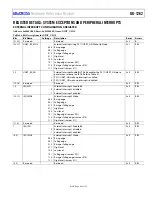
Hardware Reference Manual
UG-1262
Rev. B | Page 41 of 312
PROGRAMMING, PROTECTION, AND DEBUG
BOOTING
The processor supports the following boot modes:
Booting from internal flash. Pin setting is 1.
If the BM/P1.1 pin = 0, user code is prevented from executing. Control stays within the bootloader code with the serial wire enabled.
The user flash space cannot be viewed in this mode if the space is protected by the user flash metadata.
SECURITY FEATURES
The
processor provides a combination of hardware and software protection mechanisms that lock out access to the device in
secure mode but grant access in open mode. During startup, the system is clocked from an internal on-chip oscillator. A reset computes a
hardware checksum of the information area and then permits the CPU to execute the Analog Devices, Inc., bootloader in the flash
information area if the checksum passes. The Analog Devices bootloader inspects a GPIO boot pin, which determines whether user code
is allowed to execute or not.
The
features read protection, which protects device contents (flash, SRAM, CPU registers, and peripheral registers) from
being read through an external interface by an unauthorized user.
SAFETY FEATURES
The
processor provides a number of features that help achieve certain levels of system safety and reliability. The level of
safety is mainly dominated by system considerations, and the following safety features are provided to enhance robustness.
Multiparity Bit Protected L1 Memories
In the SRAM and cache L1 memory space, each word is protected by multiple parity bits to detect the single event upsets that occur in all
RAMs.
Debug Features
The SWCLK and SWDIO pins are used for debugging and programming. By default, an internal pull-up resistor to DVDD is provided.
To save power, users can disable the internal pull-up resistor and reconfigure these pins as tristate. Take care when reconfiguring these
pins from their default state, because this reconfiguration disables debug access to the
. It is recommended to only disable the
SWCLK and SWDIO feature of these pins in user code when code development and debugging is almost complete. If the SWCLK and
SWDIO pins are accidently converted to tristate, mass erase the device by resetting the device. Set BM/P1.1 = 0, which allows the user to
call the mass erase function of a serial wire-based debugger.
The
can also utilize the analog die watchdog timer for debugging. Disable the analog die watchdog timer when developing
or debugging user code. Enable the timer only toward the end of the development cycle. If left enabled during debug sessions,
unexpected watchdog timer resets can crash source level debugger programs and cause unexpected resets to user sensor interface.






























